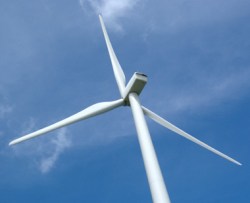 As we continue to retire aging dirty coal plant after aging dirty coal plant nationwide (we just hit 112 coal plants secured to retire), we are also pushing hard to replace them with clean energy, and as little natural gas as possible. That’s why we were excited this week to see two very large clean energy announcements from the U.S. Bureau of Land Management (BLM).
As we continue to retire aging dirty coal plant after aging dirty coal plant nationwide (we just hit 112 coal plants secured to retire), we are also pushing hard to replace them with clean energy, and as little natural gas as possible. That’s why we were excited this week to see two very large clean energy announcements from the U.S. Bureau of Land Management (BLM).
First, Interior Secretary Ken Salazar announced the completion of the final environmental impact statement for a massive Wyoming wind farm. The Chokecherry and Sierra Madre Wind Energy Project would be comprised of up to 1,000 wind turbines across private and federal land in southeastern Wyoming, and generate up to 2,500 megawatts of clean energy.
This is a great move for a state where coal mining is devastating a beautiful and critical area — the Powder River Basin. More wind power in Wyoming could mean less coal mining and fewer coal trains and coal plants in the West. It is also a smart move for a state that sees itself as an energy powerhouse, and wants to keep this role in a future that will have little to no coal in it.
For example, these 2,500 megawatts of wind power could replace the two filthy coal plants in Nevada, including the one that got highlighted this week as a major polluter next to the Paiute Indian reservation outside of Las Vegas.
It’s also approximately the same amount of power coming from one of the dirtiest coal plants in the West — the Colstrip plant in Montana. Colstrip’s pollution dirties the region’s air — including the beautiful vistas of Yellowstone National Park. The kicker is that this plant is co-owned by Puget Sound Energy, the power company that provides electricity to western Washington State, including progressive companies like REI and Microsoft. (Full disclosure: We have an ongoing campaign to get Puget Sound Energy out of the dirty coal business and put its customers’ money into clean energy that does not contribute to global warming.)
We look forward to reviewing the final environmental impact statement for these two large wind projects in Wyoming, and working with BLM to ensure that there are adequate conservation measures for two struggling bird species, the Golden Eagle and the Greater Sage Grouse.
The second great piece of news was Salazar’s announcement that the Interior Department finalized the environmental review for wind projects offshore from Rhode Island and Massachusetts:
The environmental assessment for the Rhode Island/Massachusetts Wind Energy Area will be used by the Bureau of Ocean Energy Management (BOEM) to inform future leasing decisions as part of the Administration’s “Smart from the Start” offshore wind energy initiative. The Wind Energy Area (WEA) comprises approximately 164,750 acres within the area of mutual interest identified by the two states.
Offshore wind in this area has the potential to create jobs and provide clean energy for Massachusetts, Rhode Island, Connecticut, and New York, as projects in this area could tie into all of those states.
We are pushing hard to ensure offshore wind projects move forward and that they are sited and designed in a way to protect endangered species, such as the extremely rare North Atlantic Right Whale. The release of this environmental review is an important next step by the Obama administration to help retire the remaining coal plants in the New England and Mid-Atlantic regions, end the practice of mountaintop-removal coal mining, and power the region with clean energy for decades to come.
The next step to realize the many benefits of offshore wind and catch up with the European and Asian countries that are already installing offshore wind projects is for New York Gov. Andrew Cuomo (D) and Connecticut Gov. Dannel Malloy (D) to support contracts for offshore wind projects as their colleagues in Rhode Island and Massachusetts have done.
As the Eastern Seaboard settles in for another weekend of record-breaking temperatures, with hundreds of thousands of homes without power from last week’s epic storm, it is increasingly clear that we need to accelerate the transition from energy sources that cause global warming to energy sources that don’t sacrifice our future. This change won’t happen anytime soon in Congress. It will happen, and is happening, state by state and city by city. Please join us in this struggle for our future.



